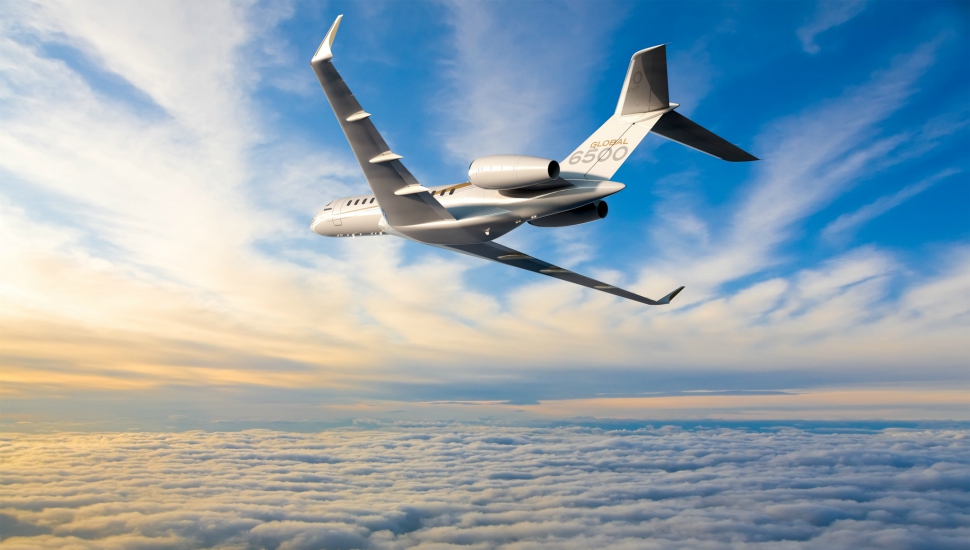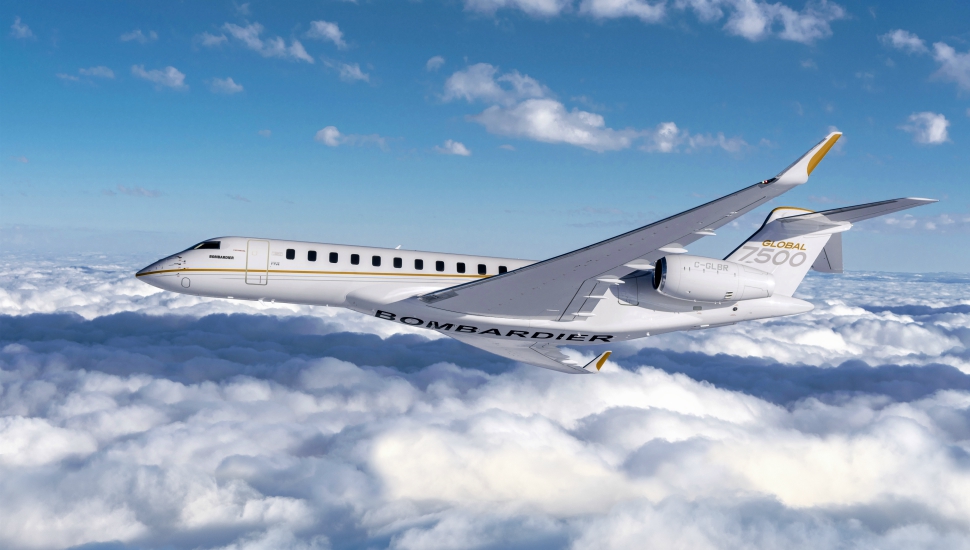Bombardier set the bar high for itself and competitors at last year's EBACE when it unveiled the Global 5500 and 6500 programme, which it had surprisingly kept secret from the industry's prying eyes.
Now Bombardier is carrying last year's splash into this year's show, highlighting the on-schedule development of those jets while unveiling updates for several aircraft in its line-up.
At the same time, recent changes at Bombardier's corporate level leave no doubt the company is betting the future of its aerospace division on business, not commercial, aircraft.
"Flight testing, production – everything is running as per plan," Bombardier vice-president of programme management Julien Boudreault recently said of the 5500 and 6500 programme. "We are confident we are going to hit what we have broadcast."
Boudreault and other executives insist the 5500 and 6500, updated versions of the 5000 and 6000, will achieve service entry before the end of 2019.
Bombardier has moved the first production-model 6500 from its Toronto Downsview manufacturing site to its Montreal completion centre, marking another milestone on the service-entry timeline. Bombardier will finish 5500s at its site in Wichita.
Three flight-test aircraft have completed 90% of 5500 and 6500 flight testing, with testing performed out of Wichita, Bombardier says. The flight-test aircraft have included two modified 6000s and one modified 5000.
Bombardier has promised the 5500 and 6500 will significantly outperform their siblings.
The 17-passenger 6500 will have 6,600nm (12,200km) range, about 600nm more than the 6000, while the 16-passenger 5500's 5,700nm range will best the 5000's reach by 500nm, it says.
Those gains partly reflect the 5500 and 6500's newly designed wing and the enhanced performance of the types' Rolls-Royce Pearl 15 turbofans, says Boudreault.

Bombardier
With 10-stage titanium compressors and new turbines and fans, R-R squeezed the Pearl 15's overall pressure ratio to 43:1, with the engine's high-pressure compressor hitting a 24:1 pressure ratio.
TECHNOLOGICAL MARVEL
"It truly is the highest-tech engine in the industry," says Bombardier vice-president of marketing and strategy Brad Nolen of the Pearl 15. "It has the highest pressure ratio of any engine in the entire industry."
Pearl 15s burn 7% less fuel per pound of thrust than the R-R BR710s that power 5000s and 6000s and generate up to 9% more thrust when departing from hot-and-high airports. The 6500 can now operate roughly 1,300nm further from such airfields. It could, for instance, reach Europe from Toluca, near Mexico City.
Bombardier also updated the 5500 and 6500's wings, particularly tweaking the trailing edge. This has boosted fuel efficiency by 13% and let Bombardier increase the aircraft's top speed to Mach 0.9.
"That wing and engine combination is translating into the longest range in the segment," says Boudreault.
For instance, the 5500 can fly from Los Angeles to Moscow, or Sao Paulo to Paris. The 6500 can connect London with Hong Kong, Bombardier says.
Bombardier also gave the 5500 and 6500 updated cockpit systems, including a "combined vision system" that displays an overlay of synthetic terrain and infrared imagery on a head-up display.
The company has updated the aircraft's cabin, too, adding 4K-resolution entertainment screens and offering an optional "Nuage" chaise lounge, which Bombardier manager of industrial design Tim Fagan calls "a first and only in business aviation".
Bombardier, which is showcasing the lounge for the first time at EBACE, designed the chaise because many customers cover onboard credenzas with cushions.
"That gave us the hint at introducing this," Fagan says.
Instead of a cushion-topped credenza, customers can order the chaise, which sits atop under-seat storage and can adjust from a lounging position to fully flat, though it is not certificated for use during take-off or landing, Bombardier says.
"This is a way of making the credenza way more functional," says Nolen.
BUSINESS END FOCUS
The 5500 and 6500 programme comes amid a broader shift by Bombardier towards focusing more on business aircraft.
Bombardier last year sold majority ownership of the CSeries (now known as the A220) to Airbus and announced the sale of its Q400 turboprop programme to an affiliate of Viking Air, an agreement expected to close in mid-2019. The CRJ programme's future seems uncertain.
Then on 2 May Bombardier announced it is combining its business and commercial aviation units into a single division called Bombardier Aviation.
"We want to focus on business aircraft going forward," Bombardier chief executive Alain Bellemare told investors during the company's first-quarter earnings call. "That's where we are putting our chips."
To that end, Bombardier continues to bolster its global aircraft services reach.
"More and more what you see from us is facilities around the world that can offer the full range of solutions," says Bombardier vice-president and general manager of customer experience Jean-Christophe Gallagher.
The company has launched an "instant feedback" service that allows customers to quickly contact Bombardier support via smartphones, and Gallagher receives the alerts daily, he says.
Bombardier is also building new service centres, such as one in Miami, and expanding others, such as its Singapore site.
"This will be the largest maintenance facility owned by any business OEM in Asia," says Gallagher of the Singapore facility. "Singapore is really the headquarters of our Asian support structure."
"The industry is headed… into large facilities that can do it all," he adds.
Bombardier currently has 59 service centres worldwide, including nine company-owned sites. It has 30 ground vehicles used to dispatch technicians to aircraft and expects to grow that fleet to 40 vehicles.
Although the 5500 and 6500 programme is Bombardier's newest, the 19-passenger 7500 remains the flagship. That aircraft, powered by GE Aviation Passport 20 turbofans, has 7,700nm (14,260km) range and can reach speeds up to M0.925.
Bombardier delivered the first 7500 in December last year to an aircraft lessor, but leased that aircraft back, placing it into demonstrator and record-setting duty.
"We've deployed it to many areas of the world, to stretch its legs as much as possible," says Bombardier vice-president of 7500/8000 programme management Stephane Loubert. "The exciting part is getting the aircraft in front of customers."

Bombardier
As of late April, the demonstrator 7500 had logged 316h of flight with perfect dispatch reliability, criss-crossing the globe, he says.
In March, a 7500 completed what Bombardier called the "longest mission ever flown by a purpose-built business jet", flying 8,152nm from Singapore to Tucson, Arizona.
Later that month, a 7500 flew 2,976nm from Westchester County White Plains airport near New York to London Luton airport in a record 5h 26min, averaging M0.92, Bombardier said.
Bombardier announced more 7500 news in April, disclosing that the aircraft has a jetlag-busting lighting technology the company calls the Soleil Lighting System.
The system uses algorithms and flight details (take-off and landing times, sunset and sunset times, for instance) to create lighting schemes designed to help passengers adjust better to time zone shifts.
For example, the system can automatically dim cabin lights shortly after take-off to encourage sleep, then bring the lights up shortly before arrival, Bombardier says.
Just two 7500s had entered service as of earlier this year, but Bombardier expects to deliver 15-20 6500s and 7500s this year, and 30-40 aircraft by 2020.
‘PIVOT’ TO 8000
The status of Bombardier's Global 8000, the sister ship to the 7500, remains uncertain, as does the 8000's potential performance.
Bombardier launched the 8000 at the same time as the 7000 in 2010, at the time marketing the 7000's range as 7,300nm and the 8,000's as 7,900nm. In 2018, however, Bombardier renamed the 7000 the 7500 to reflect improvements that brought that aircraft's range to 7,700nm.
Bombardier has meanwhile talked little of the 8000. Executives say the 7500 has generated most customer interest and concede that the aircraft's longer range has eroded the 8,000's performance benefits.
Still, Bombardier insists it will next return to the 8,000.
"We are really looking at that 7500 entry into service and making sure it's smooth, and when we finish that we will then pivot back to 8000," Bombardier says.
The 8000 would benefit from the same performance improvements that spurred the 7000-to-7500 name change, executives say, hinting that the 8000 could be remarketed as the 8500.
"Everything we've learned on the 7500 will accrue to the next airplane," says Nolan. "We have got to have a rethink of exactly what the 8000, or the 8500, is going to look like."
Also at EBACE, Bombardier revealed a package of tweaks to its 3,200nm-range Challenger 350, a 10-passenger jet powered by Honeywell HTF7350 turbofans.
The company has made braking improvements and rudder control modifications that give the 350 up to 1,500nm of additional range when departing from shorter runways, such as those with length of 1,070-1,220m (3,500-4,000ft). The aircraft can now operate from Santa Monica in California, Bombardier says.
The rudder changes affect the rudder's ability to counter asymmetric thrust should the aircraft lose an engine at take-off. The rudder’s ability to perform that role can limit take-off speeds from shorter runways, which, in turn, limits fuel and thus range, says Mathieu Noel, Bombardier director of product strategy and design.
Bombardier has now given the 350's rudder improved authority, making it more effective at higher take-off speeds, which allows it to carry more fuel, meaning more range, Noel says. The system is available on new aircraft and for retrofit to in-service 350s
"Through some changes in the flight control system, we are able to increase that speed on the runway while maintaining control of the aircraft, [and] increase, therefore, the take-off weight, and fly farther," Noel says.
Bombardier is also now offering the 350 with an enhanced-vision equipped head-up display, and has reduced the 350's cabin nose by 1-2 decibels, Bombardier says. Regulators have also granted the 350 steep-approach certifications.
2019EBACE
Find all the latest news, pictures, video and analysis from EBACE 2019 on our dedicated page.
latestnewsmainpage
Source: FlightGlobal.com






















